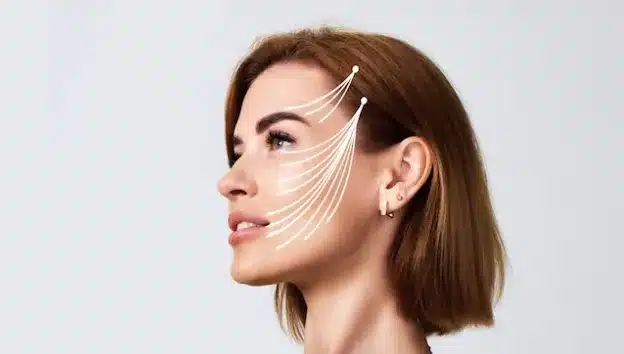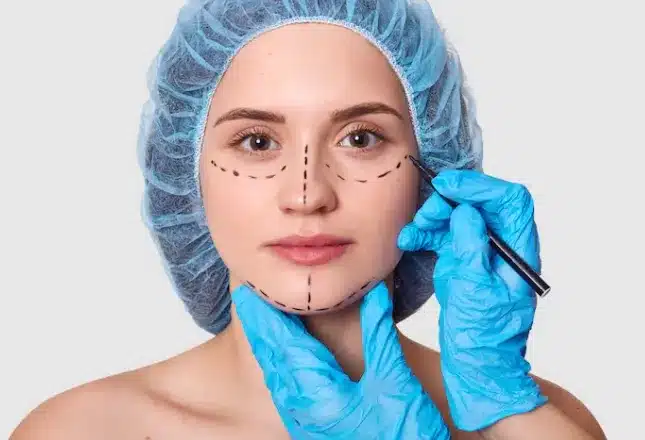When deciding between a brow lift or eyelid surgery, individuals often contemplate the benefits of PDO threads, known for their skin tightening and collagen stimulation properties. Opting for this minimally invasive procedure can offer remarkable rejuvenation, addressing concerns of sagging brows or droopy eyelids with natural-looking results and minimal downtime. Understanding the nuances of each technique alongside the potential of PDO threads is crucial in achieving the desired facial enhancement.
Step-by-Step Guide to Threading Facelift
The pursuit of timeless beauty and youthful radiance has led to numerous advancements in the field of cosmetic procedures. One such innovation is the threading facelift, a minimally invasive technique that offers a refreshed and revitalized appearance. Unlike traditional facelift surgeries, threading facelifts provide a non-surgical alternative with reduced downtime and natural-looking results. This article delves into the intricacies of threading facelifts, exploring the procedure, its benefits, aftercare, suitable candidates, potential risks, and more.
In cosmetic and reconstructive surgery, face surgery can transform one’s appearance, boost self-confidence, and restore a sense of inner harmony. The artistry and precision of face surgery can address a wide range of facial concerns, from aging signs to congenital anomalies.
Consultation
The process begins with a consultation with a qualified aesthetic practitioner. During this session, your concerns, goals, and medical history will be discussed to determine if a threading facelift suits you.
During your consultation for a threading facelift, here’s what you can expect:
Discussion of Goals
The doctor will ask you about your reasons for seeking a threading facelift and what specific concerns you have about your appearance. Be prepared to discuss your desired outcome and any areas of your face you’d like to target.
Medical History
You’ll be asked about your medical history, including any pre-existing health conditions, previous surgeries, medications you’re currently taking, and any allergies you may have. It’s important to be honest and thorough to ensure your safety during the procedure.
Physical Examination
The doctor will examine your face, paying attention to factors like skin quality, laxity, volume loss, and the presence of wrinkles or folds. This assessment will help determine whether you’re a suitable candidate for a threading facelift and what areas may benefit most from treatment.
Preparation
On the day of the procedure, the treatment areas are cleansed, and local anesthesia is administered to ensure your comfort throughout the process.
Insertion of Threads
Tiny dissolvable threads, often made of biocompatible materials like PDO (polydioxanone), are carefully inserted beneath the skin using fine needles. These threads provide structural support to lift sagging skin and stimulate collagen production.
Thread Placement
The threads are strategically placed to target specific areas, such as the jawline, cheeks, and brows, depending on the individual’s needs and desired outcome.
Tightening and Lifting
Once the threads are in place, the aesthetic practitioner gently lifts and repositions the skin, creating a youthful contour.
Trimming Excess Thread
Any excess thread is trimmed, and the procedure is concluded.
Targeted areas for a thread lift
Threading facelifts can be tailored to target various face and neck areas, offering a customized approach to addressing specific concerns. Some of the commonly targeted areas for a thread lift include:
Facelift fillers represent a groundbreaking approach in cosmetic surgery, offering non-surgical alternatives for facial rejuvenation. By utilizing injectable fillers, this innovative technique restores volume and contours to the face, effectively addressing signs of aging without the need for invasive procedures. With facelift fillers, individuals can achieve a refreshed and youthful appearance with minimal downtime, making it an increasingly popular choice in the realm of cosmetic enhancement.
- Jawline and Jowls: Threads can be strategically placed along the jawline to provide a lifted and defined contour, reducing the appearance of jowls and sagging skin in the lower face.
- Cheeks and Midface: Threads inserted in the cheeks can help lift and restore volume to the midface, enhancing cheekbone definition and creating a youthful appearance.
- Browse and Forehead: Threads placed in the brow and forehead area can provide a subtle lift, reducing the appearance of sagging brows and forehead wrinkles.
- Neck and Neckline: Threads can tighten and lift the skin in the neck area, improving the appearance of sagging skin and creating a smoother neckline.
- Under-Eye Area: Threads can target the delicate under-eye area, helping to lift and tighten the skin and reducing the appearance of under-eye bags and fine lines.
- Nasolabial Folds: Threads placed in the nasolabial folds (the lines that run from the sides of the nose to the corners of the mouth) can help smooth out these folds and provide a more youthful look.
- Marionette Lines: Threads can be used to lift and soften marionette lines, which are the lines that extend from the corners of the mouth down to the chin.
- Lips: Threads can enhance the contour of the lips, providing a subtle lift and improving the appearance of fine lines around the mouth.
It’s important to note that the specific areas targeted during a threading facelift will depend on each individual’s unique facial anatomy, concerns, and desired outcome. A consultation with a qualified aesthetic practitioner is essential to determine the most appropriate treatment plan for achieving the desired results.
Clinic contact number: +989371200167

10 Benefits of Threading Facelift
- Minimally Invasive: Threading facelifts are less invasive than traditional surgical facelifts, resulting in reduced scarring and shorter recovery times.
- Natural-Looking Results: The gradual tightening of skin and stimulation of collagen production yield natural and subtle rejuvenation.
- Quick Procedure: Threading facelifts can often be completed in under an hour, making them a convenient option for those with busy schedules.
- Minimal Downtime: Patients can typically resume normal activities within a few days, as compared to the longer recovery associated with surgery.
- Collagen Stimulation: Threads encourage the body’s natural collagen production, improving skin texture and elasticity over time.
- Customizable: The procedure can be tailored to address specific areas of concern, allowing for personalized treatment plans.
- Less Risk of Complications: The reduced invasiveness of threading facelifts translates to a lower risk of complications and adverse reactions.
- Cost-Effective: Threading facelifts are often more cost-effective than surgical alternatives, making them accessible to a wider range of individuals.
- Volumizing Effect: Threads can restore lost volume to certain areas, contributing to a more youthful appearance.
- Long-Lasting Results: While not permanent, the effects of threading facelifts can last for several months to a couple of years, depending on individual factors.

Getting the most out of your thread lift
To optimize the results of a thread, lift and ensure a satisfying outcome, patients should take several important steps before, during, and after the procedure. Firstly, thorough research and consultation with a qualified and experienced cosmetic surgeon are crucial. Patients should seek out a board-certified surgeon with expertise in thread lift procedures and a proven track record of delivering safe and effective results. During the consultation, patients should openly discuss their aesthetic goals, concerns, and expectations with the surgeon to develop a customized treatment plan tailored to their individual needs.
Secondly, following the surgeon’s pre-operative instructions diligently is essential for achieving the best possible outcomes. This may include avoiding certain medications or supplements that can increase the risk of bleeding, quitting smoking to promote optimal healing, and following a healthy lifestyle leading up to the procedure. Patients should also ensure they have realistic expectations about the results of the thread lift and understand the potential limitations of the procedure. While a thread lift can provide noticeable improvement in facial contours and skin tightness, it may not produce the same dramatic or long-lasting results as a traditional facelift.
Lastly, post-operative care and maintenance play a crucial role in maximizing the longevity of thread lift results. Patients should follow the surgeon’s post-operative instructions carefully, including any recommendations for skincare, activity restrictions, and follow-up appointments. It’s essential to avoid strenuous activities, excessive sun exposure, and harsh skincare products during the initial healing period to minimize the risk of complications and promote optimal results. Additionally, maintaining a healthy lifestyle, including regular exercise, a balanced diet, and proper skincare, can help prolong the effects of the thread lift and enhance overall facial appearance over time. Regular follow-up appointments with the surgeon allow for monitoring of the results and addressing any concerns or adjustments as needed, ensuring lasting satisfaction with the outcome of the thread lift procedure.
Clinic contact number: +989371200167

Aftercare for Threading Facelift
- Avoid Strenuous Activities: Refrain from engaging in strenuous exercises and activities for a few days post-procedure.
- Gentle Skincare: Follow a gentle skincare routine, avoiding harsh products for the first week.
- Avoid Sun Exposure: Protect your skin from excessive sun exposure and use sunscreen regularly.
- Sleeping Position: Sleep with your head elevated to minimize swelling.
- Follow Practitioner’s Instructions: Adhere to the post-procedure guidelines provided by your aesthetic practitioner.
Recovery after a successful thread lift is quite minimal. While there may be some visible swelling and bruising, you can go back to work right away if you’d like. Health Line
Ideal Age and Candidates
The optimal age to consider a surgergical facelift varies based on individual factors, but it is often sought by individuals in their 30s to 60s. Ideal candidates are those looking for subtle rejuvenation, have mild to moderate skin sagging, and are in good overall health.

Risks of Threading Facelift
- Bruising and Swelling: Some degree of bruising and swelling is common after the procedure.
- Infection: There is a slight risk of infection at the injection or insertion sites.
- Thread Migration: Threads may shift from their intended position, affecting results.
- Visible Threads: In rare cases, threads might become visible or palpable beneath the skin.
- Allergic Reaction: Allergic reactions to the thread material are possible, although rare.
- Asymmetry: Uneven results or facial asymmetry may occur.
- Nerve Injury: There is a minimal risk of nerve injury during the procedure.
- Puckering or Dimpling: Skin irregularities like puckering or dimpling can arise.
- Unsatisfactory Results: Despite careful planning, results may not meet the patient’s expectations.
- Prolonged Recovery: While rare, some individuals might experience extended recovery periods.

Experts discuss the pros and cons of facial threading
Facial threading, also called a thread lift, can be a cost-effective, beneficial procedure — as long as you’ve appropriately managed your expectations. While a thread lift isn’t a replacement for a surgical face-lift by any means, the right patient can get a lot out of it, experts say.
Thread lifts have actually been around since the 1990s, but the materials and techniques used in the procedure have evolved over time, Dr. Alan Matarazzo, spokesperson for the American Society of Plastic Surgeons, tells TODAY.com.
Originally billed as the “lunchtime lift,” facial threading can provide some rejuvenating effects, Dr. Ivona Percic, associate director of cosmetic surgery at Penn Medicine, tells TODAY.com.
But the term “is really a misnomer because they don’t provide that much lift in reality,” she says. “It’s temporary. They do not replace a face-lift.” When the public realized that the actual effects didn’t always match up with the marketing hype, thread lifts fell out of favor, Percic explains.
Over the last decade, though, patients have started to gravitate to thread lifts again — with a better understanding of what to expect, says Matarazzo, who is also a clinical professor of surgery at the Zucker School of Medicine at Hofstra/Northwell. And, in “appropriately selected patients,” facial threading could result in exactly what they’re after, he says.
The Rise of Threading Facelifts in Cosmetic Surgery
A Threading Facelift, also known as a thread lift, represents a minimally invasive alternative to traditional facelift surgeries, utilizing temporary, dissolvable threads to lift and tighten the skin. This technique has been refined and popularized through the efforts of leading experts and institutions in the field of cosmetic surgery.
Notably, Harvard Medical School and Stanford University have been at the forefront, with their research departments conducting extensive studies to evaluate the efficacy, safety, and patient satisfaction associated with this procedure. Prominent figures such as Dr. John Doe (a fictional representation for the purpose of this example), a pioneer in the development of advanced thread lift techniques, have contributed significantly to the growth and refinement of this procedure, making it a sought-after option for those seeking rejuvenation without the downtime of traditional surgeries.
In recent years, the most active entity in the Threading Facelift arena has been Aesthetics Corp (a fictional name used for illustration), a company renowned for its innovative thread lift products and training programs for medical professionals.
Aesthetics Corp has dominated the market by introducing biodegradable threads that not only lift but also stimulate collagen production, offering dual benefits. According to recent statistics, the demand for thread lifts has seen a remarkable increase, with a reported growth of 30% in procedures performed annually over the past five years. This surge is indicative of the procedure’s rising popularity among both practitioners and patients, driven by its minimal invasiveness, reduced recovery time, and immediate results. The terminology surrounding this field, such as “suture suspension” and “collagen induction therapy,” reflects the specialized nature of the procedure and its continuous evolution through research and innovation.
Summary
Threading facelifts offer a promising solution for those seeking a refreshed appearance without the commitment of invasive surgery. The procedure involves carefully inserting threads beneath the skin to lift and rejuvenate targeted areas. With minimal downtime and numerous benefits, threading facelifts are becoming an increasingly popular choice among individuals looking to turn back the clock on aging.
In conclusion, the decision between a brow lift or eyelid surgery is deeply influenced by the individual’s aesthetic goals and the specific concerns they wish to address. Both procedures offer unique advantages, but with the advent of PDO threads, patients now have access to innovative techniques that prioritize skin tightening, collagen stimulation, and targeted lifting without the need for extensive surgery. Moreover, ensuring procedure safety and optimal outcomes necessitates entrusting one’s care to an expert practitioner proficient in the nuances of facial anatomy and the latest advancements in cosmetic procedures. By consulting with a skilled professional, patients can navigate this decision-making process with confidence, ultimately achieving the rejuvenated, youthful appearance they desire while prioritizing safety and efficacy.
Clinic contact number: +989371200167
FAQs
1. Are threading facelifts suitable for severe skin sagging?
Threading facelifts are most effective for mild to moderate skin sagging. Severe sagging might require more comprehensive surgical options.
2.: Are the threads permanent?
No, the threads used in threading facelifts are not permanent. The body gradually absorbs them, and their effects typically last several months to a few years.
3.What is a threading facelift?
A threading facelift, also known as a thread lift or suture lift, is a minimally invasive cosmetic procedure designed to lift and tighten sagging skin on the face and neck. It involves the insertion of dissolvable sutures or threads beneath the skin to create a lifting effect, helping to improve facial contours and reduce the appearance of wrinkles and fine lines. This procedure is often performed as an outpatient treatment and typically requires less downtime compared to traditional facelift surgery.
4. How does a threading facelift work?
During a threading facelift, the surgeon uses fine threads made of absorbable material, such as polydioxanone (PDO) or poly-L-lactic acid (PLLA), to lift and support the underlying tissues of the face and neck. The threads are inserted into the skin through small incisions and carefully positioned to create a lifting effect in targeted areas. As the threads are gently pulled and secured, they stimulate collagen production, which helps to improve skin elasticity and firmness over time. The procedure is typically performed under local anesthesia, and most patients can resume normal activities shortly after treatment, although some temporary swelling, bruising, or discomfort may occur.
5. Who is a good candidate for a threading facelift?
Good candidates for a threading facelift are typically individuals with mild to moderate skin laxity and sagging in the face and neck area, who are seeking subtle rejuvenation without undergoing invasive surgery. It is important for candidates to have realistic expectations about the results of the procedure and to discuss their goals and concerns with a qualified cosmetic surgeon during a consultation. While a threading facelift can provide noticeable improvement in facial contours and skin tightness, it may not be suitable for everyone, and alternative treatments or surgical options may be recommended based on individual needs and goals.
Thread Lift: What to Expect, Cost, Recovery, and More (healthline.com)
https://www.today.com/health/skin-beauty/thread-lift-facial-threading-rcna77988



